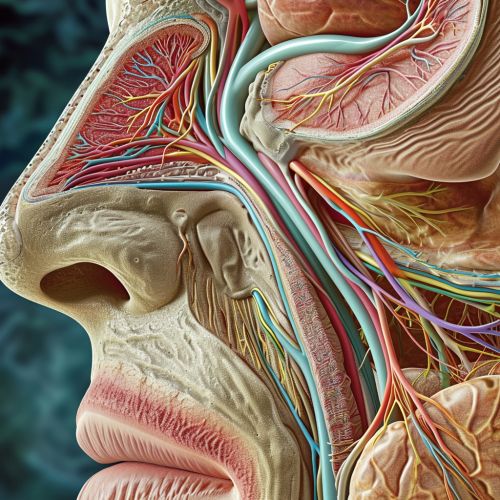Olfactory perception
Introduction
Olfactory perception, also known as the sense of smell, is a complex process that allows organisms to detect and identify volatile substances in their environment. This sense is mediated by the olfactory system, which consists of sensory neurons located in the nasal cavity, and their associated neural pathways that transmit information to the brain.
Anatomy of the Olfactory System
The olfactory system is primarily made up of the olfactory epithelium, the olfactory bulb, and the olfactory cortex. The olfactory epithelium is a specialized tissue inside the nasal cavity that contains olfactory sensory neurons. These neurons are unique in that they are exposed to the external environment and have the ability to regenerate throughout an individual's life.


Each olfactory neuron expresses a single type of olfactory receptor, a protein that binds to specific odor molecules. These receptors are located on the cilia of the olfactory neurons, which extend into the mucus layer lining the nasal cavity. When an odor molecule binds to a receptor, it triggers a signal that is transmitted to the olfactory bulb.
The olfactory bulb is a structure located at the base of the brain, directly above the nasal cavity. It receives signals from the olfactory sensory neurons and processes this information before sending it to other areas of the brain for further processing.
The olfactory cortex is the region of the brain responsible for processing olfactory information. It is involved in the perception of smell, as well as the emotional and memory-related aspects of olfaction.
Olfactory Transduction
Olfactory transduction is the process by which odor molecules are converted into electrical signals that can be interpreted by the brain. This process begins when an odor molecule binds to an olfactory receptor on the cilia of an olfactory sensory neuron. This binding triggers a series of biochemical events that result in the generation of an electrical signal.
The signal is then transmitted along the axon of the sensory neuron to the olfactory bulb. Here, the signal is processed and integrated with signals from other sensory neurons that express the same type of receptor. This integrated signal is then sent to the olfactory cortex, where it is interpreted as a specific smell.
Odor Perception
The perception of smell is a complex process that involves the integration of multiple sensory inputs. When an odor molecule is detected by the olfactory system, it is not only perceived as a specific smell, but also elicits an emotional response and may trigger memories associated with that smell.
The perception of smell is also influenced by other factors, such as the concentration of the odor, the presence of other odors, and the individual's previous experiences with that odor. This makes the sense of smell a highly subjective and personal experience.
Olfaction and Taste
Olfaction and taste are closely linked, with both senses contributing to the perception of flavor. While taste is primarily responsible for detecting the basic qualities of food (sweet, sour, bitter, salty, and umami), olfaction provides the complex flavors associated with specific foods.
When food is chewed, volatile compounds are released and travel up the back of the throat to the olfactory epithelium. This process, known as retronasal olfaction, allows the olfactory system to detect the flavors of food.
Disorders of Olfaction
There are several disorders that can affect the sense of smell, including anosmia, hyposmia, and dysosmia. Anosmia is the complete loss of the sense of smell, while hyposmia is a reduced ability to smell. Dysosmia refers to distorted smell perception, where an odor may be perceived differently than it should be.
These disorders can be caused by a variety of factors, including damage to the olfactory system, certain diseases and conditions, and exposure to certain chemicals or medications. Treatment for these disorders depends on the underlying cause and may include medication, surgery, or smell training.
